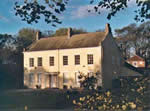In 1771 Lt. Governor Michael Franklin of Nova Scotia travelled to northern England to seek immigrants. He was looking for skilled farmers who could take up lands formerly cultivated by the displaced Acadian minority, and who could counterbalance growing republican sentiment within both Nova Scotia and the Colonies to the south. For five years, until the British Government began to grow alarmed at the scale of emigration to North America, agents actively recruited settlers in Yorkshire .
The first of these Yorkshire emigrants arrived in 1772 aboard the Duke of York. This vessel departed Liverpool on March 16, 1772 with sixty-two passengers, and reached Fort Cumberland on May 21, 1772. On board were Charles Dixon, Thomas Anderson, George Bulmer, John Trenholm and others. During the period 1773-1775 additional vessels left for Nova Scotia, the largest number arriving during the spring of 1774, when nine ships carried settlers from England to Halifax.
In all, more than one thousand people emigrated from Yorkshire and Northumberland to Nova Scotia (including parts of what later became New Brunswick) between 1771 and 1776. As a group, they comprise 'The Yorkshire Emigration', a significant event in the history of the Maritime provinces. The settlers shared a common language and dialect, a pioneering spirit and — as the years passed — strong bonds created by intermarriage. Many were Methodists, and instrumental in the establishment of the Methodist Church in Canada. Almost all remained loyal to Britain during the Eddy Rebellion, thus helping to determine the future of both Nova Scotia and the future nation of Canada.
Gord Ripley
Teeswater, Ontario


